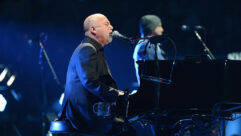
Spreading the Word with CBN, Part 2
Jul 7, 2011 10:46 AM,
with Bennett Liles
Listen to the Podcasts
|
Editor’s note: For your convenience, this transcription of the podcast includes timestamps. If you are listening to the podcast and reading its accompanying transcription, you can use the timestamps to jump to any part of the audio podcast by simply dragging the slider on the podcast to the time indicated in the transcription.
At the studios of CBN, the Christian Broadcasting Network, they are live news feeds, music shows, and fast technical turnarounds. They needed a digital audio console that was feature heavy and light on its feet for reconfiguration. They chose the Calrec Artemis and director of audio services Phil Peters is here to provide all the details on the new board’s installation next up on the SVC podcast.
Phil, thanks for being back with me for Part 2 of the SVC podcast from CBN, the Christian Broadcasting Network, where you have a new Calrec console. We talked a little about this in Part 1, what was the reaction from your production audio operators when you brought the Calrec in with all its features? I would think that some would take to it faster than others.
Yes, some do take to it faster than others. Overall it’s been extremely positive. There are things that its…obviously it does differently than the console that we had in there before and so the guys have had to adapt a little bit but everyone of them has expressed how much they’ve enjoyed working on it and the wow factor has been pretty large. [Timestamp: 1:26]
Right, and in that kind of an environment some things have to happen pretty fast and you don’t have time to twiddle around much, so being able to hit the ground running on this thing would be pretty important.
That’s true, and so we had several days of intensive training with the guys and then ongoing one on one sessions almost daily to just try to go over new features and we talk about different situations…things that may come up and make our own little mock problems and then work through how we would fix them. [Timestamp: 1:54]
And once you got the Calrec Artemis in and you got some people trained on it and got to use it on actual programming, were there any sort of surprises or changes or tweaks that you had to make since the first installation?
Not really, we were able to set it up for almost a month before, and through the MADI interface we were able to mimic and actually have the same mics and sources to build our shows in advance so it was a situation where we were really ahead of the game when change-over day came. We switched over on a Friday evening and Monday morning put it on air with really no issues to speak of. [Timestamp: 2:29]
Well, that’s a great way to have it happen. It doesn’t always turn out that way but I’m glad it went well for you. Now we talked about audio stuff, but I know people are curious about what you use for cameras and how you do video switching there too.
We use the Sony, the HDCU1000 cameras, and then we use the Snell & Wilcox Kahuna switchers in all of our control rooms. [Timestamp: 2:51]
And same situation there about getting people trained and rotated into the loop and getting them used to making things happen quickly.
Absolutely.
So digital audio on twisted pair—is that what you got coming into there from the studios or do you handle everything on the multi-pair copper snakes or how do you get it from the studio?
We have actually a combination, the original wireworks wiring that they did in this building 30 some years ago, we still use every day and so the main production mics, the wireless—all of those are connected through the multi-pair copper. When we host bands we have a full Ether sound solution that we use for monitor mixes, ears, wedges, whatever the band may need and take a split from that for the production consoles. [Timestamp: 3:39]
And you’ve obviously got a lot of stuff coming in from outside and a lot of times feeds coming in on very short notice, so how do you do field shooting and editing and posting? I know some places have producers assigned to specific programs and in some they have people from outside operating independently. So what’s your situation there?
We use, for the most part, an in-house—what we call them, feature producers that will develop and put together the packages that run on air. They’ll go out with a small shooter/editor-type crew depending on whether it’s a news-oriented piece or a magazine-style piece will pretty much determine the timeline by which it’s shot and edited and then put to air. If it’s a news piece it can be shot, turned around in just a few hours and they will, in that case, laptop Final Cut Pro; edit the piece and in some cases FTP it back to us or if they’re able to get it to a place where they could send it out over satellite they will do that as well. The feature side of it when we do the magazine style shows they’ll go shoot, bring it back, end—some producers will edit at their desk on Final Cut or Adobe Premiere. In either case, they bring it to a finishing suite for color correction and then final editing and then most of those pieces come through audio post for suiting with Steinberg’s Nuendo and from there it goes to air. [Timestamp: 5:02]
Spreading the Word with CBN, Part 2
Jul 7, 2011 10:46 AM,
with Bennett Liles
Well, they’ve got to stay loose and take advantage of things coming in from the outside, but sometimes unforeseen things happen inside right there in the place. That Calrec console with all its great features on it; how does handle a power interruption? Have you ever lost power? And how fast does it come back up and re-gain its composure or are you pretty well protected on that?
Well thankfully the entire technical plan is on a large UPS. The local switch from the power company switching over from that to the UPS happens in a very, very short amount of time so that hasn’t been an issue. The Calrec itself has dual power supplies on every I/O box, dual power supplies on the console itself so we have those on separate legs of the power—hasn’t really been a problem thus far but I will say if we had to shut down and fully re-boot the entire system comes up in under 2 minutes and if it is just a simple console re-boot that comes up in under 30 seconds. [Timestamp: 6:06]
And you’re doing quite a bit of live programming aren’t you?
That’s correct. We do generally 25-27 live shows a week out of this one particular studio. [Timestamp: 6:15]
And that makes a big difference in the atmosphere for all the people on the production team for sure.
Yes it does, it’s the…you don’t have the ability to go back and do a take two on most everything. Our main production program, the 700 Club, goes out live to probably half of our audience when we shoot it here and then it’s syndicated throughout the rest of the day in other parts of the country. [Timestamp: 6:38]
You’re in the position of the one who makes sure that everybody knows what they’re doing particularly on the audio stuff. I know that anybody who’s been in that sort of job for a good while can compare what it was like training people on an analog board. Some of the early digital mixers were fairly difficult to wrap your mind around—so would you say it was easier to learn on the new digital boards or back in the day on the analog mixers?
To me the analog is still the starting point. If you train on the new digital mixers now like the Artemis, I find myself still referring back to the analog counterpart and in some cases we’ve setup a little analog mixer beside the digital one so that we can show, “This is what the knob looks like for high-shelf, this is what the BUS switching looks like going to a particular group,” and then you move from that into the virtual digital world and it becomes easier, I think, for people to conceptualize, “OK I’m pressing this touch screen but this is actually what it’s doing in real life.” [Timestamp: 7:4]
And it seems one of the primary goals of the designers of digital boards was to make it operate like an analog mixer especially in how easy it was to get to things on it.
Correct, and in fact, the Artemis has this what they call “wild’s mode” where it operates almost like a traditional in-line console. You can see on a channel by channel basis each of the knobs, each of the assignments, each of the EQ’s and so for guys that come right from analog and have really no digital background it makes it much, much easier to see, “OK this is actually what this button does,” instead of having one central panel that just assigns every particular channel strip. [Timestamp: 8:19]
So what are things like at the other end of the mic chain? Do you use a lot of wireless gear?
We do—all of our talent prefers to be on wireless so we use Sennheiser’s 3000 series and 5000 series…specifically the 37/32 receivers and the 30/63 body pack transmitters and then the handheld’s are the 5000 series so we’ve been very, very happy with those. [Timestamp: 8:41]
And you’ve got a remote antenna set up for all that?
We do—we have a combination of active antennas and some helicals for the in ears as well. We use the Sennheiser G3 in ear systems. [Timestamp: 8:54]
Well you know sometimes installing wireless mic systems can be more of an art than a science with all the variables. So were there any re-do’s or any interference things you had to get around on that?
Once we got past the initial DTB transition with the local station changing their transponders on a weekly basis the only real challenge was just overcoming some of the background. We have a large military installation close to us and Professional Wireless Systems was a big help in matching antenna cables with the right powered antenna or the right helical and we’ve been pretty interference free for a while now. [Timestamp: 9:33]
Yeah the RF situation lately has been a fast 6-handed game on avoiding interference and anticipating all these new mobile transmission sources.
Yes it sure is. [Timestamp: 9:43]
Well, Phil, I appreciate your taking time out to tell us about this I’ve watched CBN and always wondered what it was like behind the scenes and you’ve really given us a good glimpse into how you do things there especially with the Calrec Artemis mixer that you got running now. Thanks for being here to give us the details on it.










